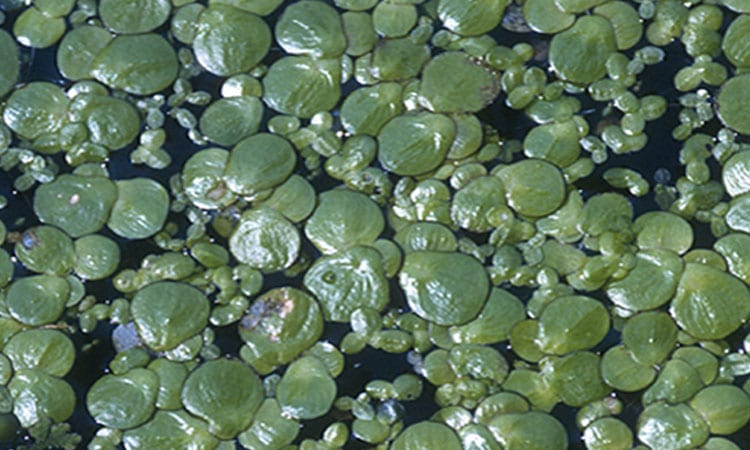Giant Duckweed is identified by a pale green layer of algae-like plants with a purple underside covering stagnant or slow moving water
- English Name: Giant Duckweed
- Latin Name: Spirodela Polyrhiza
- Life Cycle: Perennial
- Propogate: Mostly by buds, also by seeds.
- States Affected: Is a native weed, found across the United States
- Dangers: Blocks sunlight from reaching submerged plants, affects boating and recreation
- Control Methods: Nets, Rakes, Removal tools, DeSkuzzer
Floating Lake Weeds
The Giant Duckweed is the largest of the duckweed family weeds, although it is still less than 1cm long. It’s one of the four most common duckweeds in the US, the others being the more common Lemna duckweed, the even tinier rootless Watermeal Wolffia, and the dotted or Punctate duckweed.
Duckweeds are like the bridge between microscopic algae and real plants. They behave and live as plants but also break a few rules of being a plant. For one, they are incredibly tiny for plants, all of them never reaching a cm in size. They are in fact so small most people looking at a blanket of them on water usually mistake them for algae.
They are also free-floater that literally never put down roots. Instead they have stems that hang in the water, forming an entangling mess that keeps them together and improves their strength against wind and currents. And, unlike other plants, also use the underside of their leaves to draw nutrients from water, which technically makes their leaves not leaves. Then, like algae, Duckweeds are extremely fast breeders that are able to double their area of coverage within 36 hours.
The Difference between Giant Duckweed and other Duckweeds
The Giant Duckweeds are found in lakes, marshes, ponds, dugouts and streams across the US. They prefer water with high levels of nitrate and phosphate common in industrial pollutants and will grow well both in the open sunlight and in partially shaded settings.
What sets the Giant Duckweed apart from the other duckweeds is, first, the size. By Duckweed standards, having leaves that are about 6 mm across is being a giant. The other duckweeds, particularly the Watermeal, are less than half that big.
But the Giant Duckweed – scientific name Spirodela – is also different in that its leaves have a purple underside, a feature than other duckweeds do not have. The leaves are also more rounded than oval and although they are green on the top-side, they are paler than the most common – the Lemna – duckweed.
A closer look will also show that each Spirodela plant has between one and four leaves and three to nine of those root-stems that never reach the water bed. The number of leaves and root-stems is important because they vary according to duckweed type.
Like its cousin Duckweeds, the Giant Duckweed is a perennial plant that survives the seasons by producing buds in winter that sink to the bottom of the pond to wait for the next season. The buds called turions are their main method of reproduction and form at the base of the leaves. Each “leaf” can form buds several times before it withers with old age.
Giant Duckweed Control
Like all Duckweed, the Spirodela is a popular food source for most water animals and birds. It is also a water-cleaner of sorts because of its love for nitrate and phosphate, which enables it to do a good job in breaking down sewage, animal waste and some industrial pollution. Also, because of its unusually high protein content and minerals, it is a premium animal feed source.
But, again the other duckweeds, it does become a nuisance weed in most instances, in part because it grows so fast that not even birds and animals can keep pace. When that happens, the typical removal method is to drag the plant out of the water using rakes or, less often, nets. The DeSkuzzer, one of our weed control products, is particularly suited for the task because of its long reach and ability to cover a wide surface area quickly. It is a 5 foot wide floating seine with sturdy abrasion, ultra tough screen, and a 24 foot pull line.

